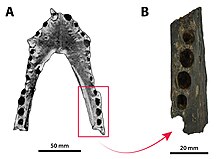1886 in paleontology
| |||
|---|---|---|---|
| +... |
Paleontology or palaeontology is the study of prehistoric life forms on Earth through the examination of plant and animal fossils.[1] This includes the study of body fossils, tracks (ichnites), burrows, cast-off parts, fossilised feces (coprolites), palynomorphs and chemical residues. Because humans have encountered fossils for millennia, paleontology has a long history both before and after becoming formalized as a science. This article records significant discoveries and events related to paleontology that occurred or were published in the year 1886.
Flowering plants
[edit]Superasterids
[edit]| Name | Novelty | Status | Authors | Age | Unit | Location | Synonymized taxa | Notes | Images |
|---|---|---|---|---|---|---|---|---|---|
|
Sp nov |
Jr synonym |
(Casp.) Sadowski & Hofmann |
A Symplocaceous flower species. |
 |
Ichthyosaurs
[edit]New taxa
[edit]| Name | Status | Authors | Age | Unit | Location | Notes |
|---|---|---|---|---|---|---|
|
Valid |
Bassani |
Late Triassic (Carnian) |
Type species of the mixosaurid genus Mixosaurus Baur, 1887. |
Archosaurs
[edit]Newly named basal archosauromorphs
[edit]| Name | Status | Authors | Age | Unit | Location | Notes | |
|---|---|---|---|---|---|---|---|
|
Bassani |
Junior synonym of Tanystropheus, a member of Protorosauria. | ||||||
New pseudosuchian taxa
[edit]| Name | Status | Authors | Age | Type locality | Country | Notes | Images |
|---|---|---|---|---|---|---|---|
|
De Vis |
Pallimnarchus was informally named, but the name acquired widespread use. The syntype material consisted of multiple individuals of different crocodilian species and a later erected lectotype was lost. It was eventually declared a nomen dubium, with much of the material transferred into the genus Paludirex.[4] |
 |
Synapsids
[edit]Non-mammalian
[edit]| Name | Status | Authors | Age | Unit | Location | Notes | Images |
|---|---|---|---|---|---|---|---|
|
Valid |
Gaudry |
Millery Formation |
|||||
|
Invalid |
Red beds |
References
[edit]- ^ Gini-Newman, Garfield; Graham, Elizabeth (2001). Echoes from the past: world history to the 16th century. Toronto: McGraw-Hill Ryerson Ltd. ISBN 9780070887398. OCLC 46769716.
- ^ Sadowski, E.-M.; Hofmann, C.-C. (2023). "The largest amber-preserved flower revisited". Scientific Reports. 13 (1). 17. doi:10.1038/s41598-022-24549-z. PMC 9837116. PMID 36635320.
- ^ De Vis, C.W. (1886). "On remains of an extinct saurian". Proceedings of the Royal Society of Queensland. 2: 181–191.
- ^ Ristevski, J.; Yates, A.M.; Price, G.J.; Molnar, R.E.; Weisbecker, V.; Salisbury, S.W. (2020). "Australia's prehistoric 'swamp king': revision of the Plio-Pleistocene crocodylian genus Pallimnarchus de Vis, 1886". PeerJ. 8: e10466. doi:10.7717/peerj.10466. PMC 7759136. PMID 33391869.
